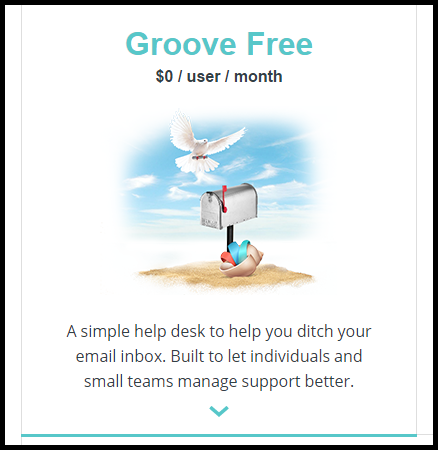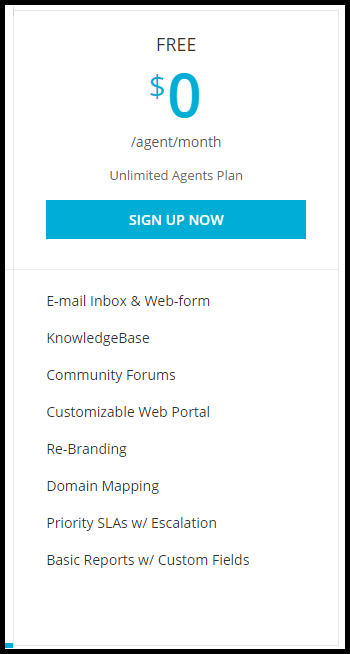Last week, two startup employees were asked to help streamline the onboarding and educating of new users into their company’s software product.
They started researching which tools similar businesses were using to help guide new users, and decided they liked the look and functionality of a popular onboarding tool called Intercom.
These employees played around with the free trial, and were pretty psyched to get it up and running on their site… until they saw how Intercom’s sliding price scale worked: They realized that the cost of the service would quickly balloon to hundreds of dollars per month as they gained users.
I was one of those employees, and in that moment I came to two sudden and harsh realizations:
Realization #1 was that it doesn’t matter if a product was ‘industry standard’ or ‘used by a lot of successful companies,’ most small businesses just aren’t going to have the budget to pick up the same automated tools their larger competitors are using.
and
Realization #2 was that one of the places this need to conserve funds can become a real contradiction for small businesses and startups is when it comes to customer service; no matter what your business does, providing excellent customer support and building relationships with satisfied customers is a make-or-break operation you can’t compromise on.
The bad news here is that bypassing paid options for customer support servicing will mean you need to put in some creativity and legwork to get the same results. The good(-ish) news is that you’re probably no stranger to either if you’re running your own business.
So how can you handle and organize customer support like a pro without breaking the bank?
Here are my 11 (whacky) ideas for killing it in customer support as a small business/startup.
Every suggestion on this list is completely free.
1. Groove.
Groove is a relatively new helpdesk software that has been documenting its growth through its own highly relevant startup blog over the past couple of years. If you’re a regular reader of the blog here, you know we’re big fans of these guys. While Groove has paid options for extra functionality, they have a completely free version as well for small businesses looking for a slick, intuitive way to start managing their customer support.
They’ve got some great features that can be a big efficiency boost for those currently relying primarily on email for their support right now. I could list out the features, but heck, I might as well just let this pretty screenshot from their website do it for me:
2. Trello
Trello is an interesting tool, and one that I’ve been playing around with a lot for the past couple of weeks. Is it designed for customer support? No, but its ability to be applied to just about any organizational activity got me thinking that it might not be a bad way to manage support tickets early on.
Trello works by assigning tasks or cases as ‘Cards’, and then moving Cards between various columns in a layout board that lets you organize activities. You can also add notes to Cards, give them labels, place a check list on them, etc.
Below is an example of how you might use a Trello board to handle your support emails or requests as they come in.
When a support query comes to you, create a card for it with the customer’s details and their message. Once you’ve determined what actions can be taken to help them resolve their issue or answer their question fully, add a checklist to the card and drag it to the ‘in-progress’ column.
Once resolved, drop the ticket in the Resolved column for safekeeping!
Plus, you could even color-code your Cards to help various team members know where their help is needed; this is especially relevant when you don’t have a dedicated support team. For example, perhaps all support questions pertaining to technical aspects of your product are flagged in blue, so that one of your developers or engineers knows that question is best suited for them to answer, rather than a salesperson.
3. Get Social with Your Support
You may have noticed the growing popularity over the past few years of companies creating social media accounts, namely twitter, completely dedicated to servicing customer support needs. Offering support via social media is great because…
- It’s a native interaction platform for key youth and young adult demographics
- You can be ultra-fast in your responsiveness due to push notifications being sent to your phone, tablet, or PC whenever someone asks you something
- You cultivate the image of a dedicated support department, even if you haven’t reached that stage yet
- It’s free, hooray!
It’s really as simple as opening a Twitter account, naming something along the lines of @CompanyNameSupport, and adding links and imagery to your website that let people know they can tweet at you with their questions and feedback!
If you’re already managing a lot of social media channels and aren’t sure you want another Twitter account for your company to look after, consider using the free Tweetdeck tool (by Twitter) that lets you easily monitor and respond from multiple twitter accounts without constantly signing in and out.
Bonus idea: Twitter is the go-to for social support, but if your customers largely interact with you via mobile, what about using Instagram as a support channel? There’s a lot of potential in uploading quick, image-heavy tutorials to this social giant in order to amass a visual support library for your users.
Because Instagram hosts your images in an online browser-based platform as well, you can embed or link to these images from other social channels or pages on your site as well!
It sounds kind of whacky, but everything does – until someone does it really well, and then everyone else is kicking themselves for not thinking of it first. If you try this out, make sure you make quick guides with just a couple lines of instruction, at least a little visual design effort, and at a resolution that will still be legible/get the message across on a small mobile screen.
4. Build a knowledgebase
Ideally, you’ll always want to be available to support your customers in real-time, but self-help isn’t all bad when organized and carried out correctly! There are a lot of both free and paid tools which allow you to create a library of knowledge topics surrounding your business, which are great for FAQ’s, introductory materials/tutorials, etc.

Our simple customer self-service knowledgebase is hosted by ZenDesk, but you can easily create your own!
That said, why not keep it on the cheap and retain complete control by building your own library?
It’s not too difficult to mimic the kind of Zendesk documentation libraries you often see sites using your own platform. For many, this might mean coding some new pages or simply adding them in WordPress, but it’s pretty simple either way!
Your structure can be as simple as my (poorly crafted) wireframe below, and you’ll quickly and easily be relieving customer stress by letting them easily find answers to anything that might be tripping them up. That said, people learn differently, and while some will appreciate self-help options, others will see them as a cop out and you should always make support contact information readily available, even with an excellent knowledgebase in place!
But wait: Our own site is custom made, and the blog section is the only part which runs on WordPress (and thus uses an easy-to-access content management system). If you find yourself in need of creating a self-made knowledgebase without a lot of development skills, know that you can use free services like Weebly or Wix (or any of a million others) to create a self-help site using drag and drop tools, then simply host it as a subdomain of your main website (something like helpdocs.companyname.com, etc.).
5. Zopim (ZenDesk’s free chat support software)
Speaking on ZenDesk, it’s kind of one of the old standbys in offering businesses a support helpdesk. Unfortunately, it’s design has started to show its age, and its pricing makes many of its features inaccessible to operations just starting out.
That said, there is a completely free live chat ZenDesk developed as its own product called Zopim that might just be perfect for your business. It only allows you to have one chat at a time with customers, but depending on the volume of customer communications you’re receiving each day that may be just fine! Just because you see it everywhere, don’t underestimate the power of livechat – we get regular chat inquiries from our customers and they appreciate the near-instant response time we’re able to provide with it.
6. Add Disqus… to your product pages?
Here’s an odd one, but hear me out: Disqus is a common comment plugin that can be embedded on just about any web page. It’s most commonly used for blogs (and you can see it in action at the bottom of this very post!), but I think we can get a bit more creative and use Disqus as a support tool!
On any of your pages where users might have questions, even within your product pages if you sell some sort of software or browser-based tool, why not invite support questions publicly with a Disqus comments section?
This way, users on a page who have a question may scroll down to find that it’s already been asked and answered. By responding here, you’ll be able to actively create a knowledgebase that is directly relevant to the page users are on at that given moment.
Plus, Disqus gives you the ability to easily moderate comments, so you’ll be able to quickly and easily keep your comments within the support focus you want to cultivate for that page.
7. Use feedback surveys creatively!
As a company that deals with surveys every day, we’ve seen some pretty creative methods of collecting feedback.
How can you use a survey to take your customer care to the next level? Well, you can certainly implement standard customer feedback surveys anywhere appropriate, but let’s go even deeper:
How about modifying your contact forms to collect initial information better? Especially as the volume of customers you deal with increases, it’s a great idea to pre-sort your feedback in a way that will keep you from wasting you or your customers’ time. This can help you from having to ask the same initial questions in every email or live customer conversation, and from a customer perspective it will represent less time from initial contact with a human being at your company to having their issue resolved.
Here’s an example of a contact form you might create to help pre-collect support information form customers:
8. A Free Zoho Support Desk Account
Zoho is one of those companies that I can’t ever quite wrap my head around because the sheer range of their product offering is just massive. In fact, it seems like a fair statement to say that you could probably augment almost every part of your business, from sales, to support, to employee communication, with something these guys and gals have developed.
Lucky for us, they’ve got an easy to use CRM-specific tool that is absolutely free for up to 10 users (and if you’re reading this article, it’s likely you’re like us and it will be some time before having 10 users servicing your support and CRM is an actual limitation!).
In its free plan, Zoho lets your business manage tasks and events, keep track of customer contact information, create a support documentation library, create contact and followup forms, get reports on how you’re doing, and about 30 other things that make us wonder why more products can’t be like Zoho and offer damn near everything in their free plans.
9. Get Personal via Skype
One of the staples of many companies who successfully bootstrapped themselves to profitability and loyal customer followings is that they took the things that sounded tough, time consuming, unscalable, and maybe even boring, and did them anyways.
Let’s face it, offering to give live one-on-one Skype support to your customers whenever they need it isn’t exactly the most sustainable move in the world as your customer base grows, especially with a small team – but you should do it anyways.
This type of personal attention is absolutely essential in cultivating initial opinions of your company and helping bring your first brand advocates on board.
There are plenty of companies subscribing to the method of over-delivering in support value, especially early on, even when it’s inconvenient, and it’s paid off for them. Groove’s blog has a post titled “How We Got 2,000+ Customers By Doing Things That Didn’t Scale, in case you needed some proof.
Instead of thinking of it as an inconvenience, however, consider it an advantage you have over large competitors: You can give your customers game-changing individual attention that they just can’t; I know that a company offering to walk me through my support query over Skype, at no extra charge, would probably win me over.
10. Texting.
For some, smartphones represent the easiest or even the only gateway to the internet, so why not reach people right where they’re already spending their time, and offer text support? You likely already have a phone plan for personal use, most of which come with unlimited texting these days, so you can probably implement this with no extra investment.
If you place a block on your website advertising that you offer text support, it probably won’t take long for someone to reach out to you.
Note: If you opt to offer text support, make sure that you maintain the professionalism that would one would expect from traditional support channels. Depending on the audience and voice of your business, you might get away with some text shorthand, but always err on the side of professionalism here!
If you’re wary of spending the time it takes to type out a text response, remember than you can always link up a bluetooth keyboard with many phone and tablet models, making it easy to type out lengthy replies without killing your thumbs. Alternatively, you can use Google Voice or a similar service to get a phone number right on your computer and text/call customers with that.
11. Google spreadsheets
For some, the classic look of a spreadsheet layout makes more sense and is more intuitive than visual organization solutions (like Trello, for example). So while this option might not be a groundbreaking jolt of creativity, it’s important to remember that bare bones options exist.
Keeping track of your support tickets in a spreadsheet allows you to easily make checkboxes as each inquiry is serviced, add notes to cases about changes you might want to implement, keep track of response time, and more.
And, of course, it’s a free suite of toned down MS Office replacements, so you can cut a lot of costs by using these free docs, spreadsheets, and drawing tools for just about anything (customer service related or otherwise).
Ultimately, what works for your business when it comes to customer support will likely differ from what works for others.
But my hope is that it’s clear now that, with a dash of creativity and work, you can service your initial customer service needs without spending a dime. If you’re a small business or startup struggling with how to blow your customers away without breaking the bank, maybe that’s a reassuring prospect.
Got any other customer service or CRM tools you think should make it onto the list? Have a question about something discussed in the post? Learn something new? Drop a comment, I always love to hear your thoughts.
All the best,
Brandon
Brandon Landis is the Chief Customer Success Wizard and Community Manager for Responster, the cross-platform survey tool that helps businesses make smart decisions.










